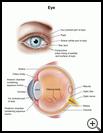
Eye Injury: Optic Nerve
________________________________________________________________________
KEY POINTS
- The optic nerve carries messages from your eyes to your brain. A severe injury to your optic nerve may cause permanent changes in your vision.
- Treatment depends on the type of injury you have, and may include medicines or surgery.
________________________________________________________________________
What is traumatic optic neuropathy?
The optic nerve connects your eyes to your brain. It carries the visual messages that you see to your brain. An injury to your optic nerve is called traumatic optic neuropathy. If your injury is severe, you may have permanent changes in your vision.
What is the cause?
Traumatic optic neuropathy can be caused by a direct injury to the optic nerve, or injuries near the nerve can cause damage from swelling, bleeding, or infections. Damage can happen with any injury to your head or eye socket such as:
- Falls
- Car or bike accidents
- Sports injuries
- Being punched, kicked, stabbed or shot in your eye
- Complications of surgery in your eye socket, brain or sinuses
What are the symptoms?
Symptoms may include:
- Vision loss in one eye that may worsen over several days
- Trouble seeing colors or everything looking dim
- Pain and swelling in your eye
How is it diagnosed?
Your eye care provider will ask about your symptoms and medical history and do exams and tests such as:
- An exam using a microscope with a light attached, called a slit lamp, to look closely at the front and back of your eye
- An exam using drops to enlarge, or dilate, your pupils and a light to look into the back of your eyes
- A test of the way your pupils react to light. Traumatic optic neuropathy makes your pupil react abnormally to light
- An eye test in which a camera takes pictures of the blood vessels inside your eye after dye is injected into a vein in your arm.
- A visual field test, which uses spots of light to measure your central vision and how well you see things on all sides
- Color vision tests to check the optic nerve
- CT scan, which uses X-rays and a computer to show detailed pictures of your eye socket and brain, including the optic nerve.
- MRI, which uses a strong magnetic field and radio waves to show detailed pictures of your optic nerve and your brain
How is it treated?
The treatment of traumatic optic neuropathy depends on the type of injury. If there is pressure on the nerve in your eye socket from blood, bone, or air, you may need surgery to relieve the pressure. You may also need eye drops or other medicines. Your provider will explain which treatments are best for you.
How can I take care of myself?
Follow the full course of treatment your healthcare provider prescribes. Ask your healthcare provider:
- How and when you will get your test results
- How long it will take to recover
- If there are activities you should avoid and when you can return to your normal activities
- How to take care of yourself at home
- What symptoms or problems you should watch for and what to do if you have them
Make sure you know when you should come back for a checkup. Keep all appointments for provider visits or tests.
How can I help prevent traumatic optic neuropathy?
If you are injured and have changes in your vision, contact your healthcare provider right away.

